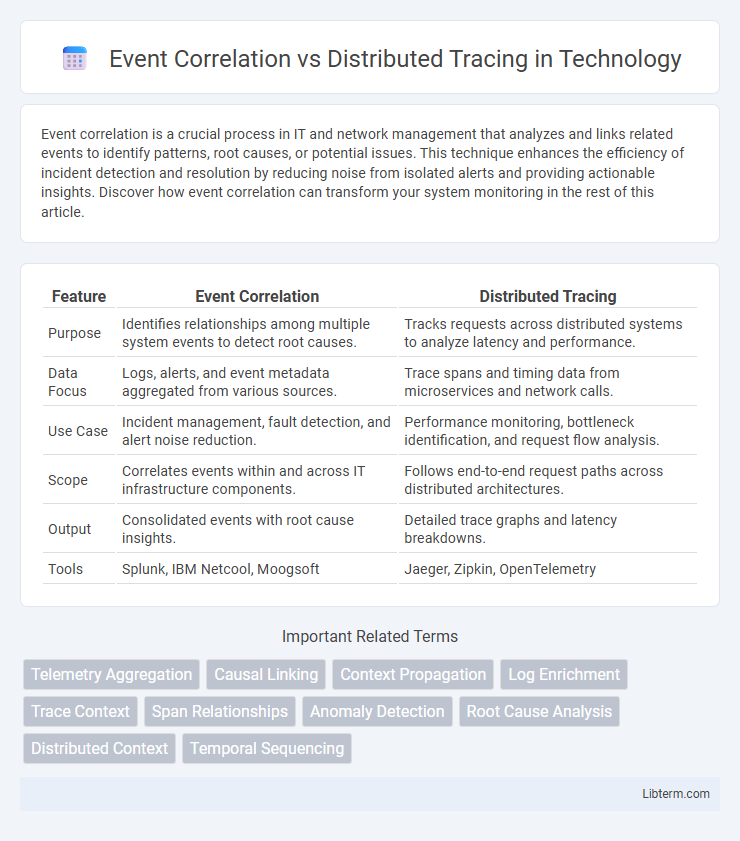Event correlation is a crucial process in IT and network management that analyzes and links related events to identify patterns, root causes, or potential issues. This technique enhances the efficiency of incident detection and resolution by reducing noise from isolated alerts and providing actionable insights. Discover how event correlation can transform your system monitoring in the rest of this article.
Table of Comparison
| Feature | Event Correlation | Distributed Tracing |
|---|---|---|
| Purpose | Identifies relationships among multiple system events to detect root causes. | Tracks requests across distributed systems to analyze latency and performance. |
| Data Focus | Logs, alerts, and event metadata aggregated from various sources. | Trace spans and timing data from microservices and network calls. |
| Use Case | Incident management, fault detection, and alert noise reduction. | Performance monitoring, bottleneck identification, and request flow analysis. |
| Scope | Correlates events within and across IT infrastructure components. | Follows end-to-end request paths across distributed architectures. |
| Output | Consolidated events with root cause insights. | Detailed trace graphs and latency breakdowns. |
| Tools | Splunk, IBM Netcool, Moogsoft | Jaeger, Zipkin, OpenTelemetry |
Introduction to Event Correlation and Distributed Tracing
Event correlation involves aggregating and analyzing multiple system events to identify patterns, root causes, and operational issues within complex IT environments. Distributed tracing provides end-to-end visibility by tracking requests as they propagate through microservices, enabling detailed performance monitoring and troubleshooting. Both techniques enhance observability but focus on different aspects: event correlation emphasizes pattern detection from logs and events, while distributed tracing concentrates on request-level latency and flow analysis.
Defining Event Correlation
Event correlation is the process of analyzing and linking multiple events from different sources to identify patterns, root causes, or impacts within an IT environment. It enables efficient incident management by filtering noise and consolidating related alerts into a single actionable item. Unlike distributed tracing, which tracks individual transaction flows across components, event correlation focuses on aggregating diverse event data for comprehensive situational awareness.
Understanding Distributed Tracing
Distributed tracing captures detailed data about the path and performance of requests across microservices, enabling precise identification of latency and failures within complex distributed systems. It provides a unified view of interactions by tracing requests end-to-end, correlating spans to visualize the entire transaction flow. Unlike event correlation, which aggregates and analyzes logs or events after the fact, distributed tracing offers real-time insights into system behavior, improving root cause analysis and performance optimization.
Core Differences Between Event Correlation and Distributed Tracing
Event correlation analyzes and aggregates logs or alerts to identify patterns and root causes across multiple systems, enabling efficient incident management. Distributed tracing tracks the entire lifecycle of individual requests through microservices, providing detailed performance data and pinpointing latency or failures within specific service interactions. While event correlation offers broad contextual insights for system-wide anomalies, distributed tracing delivers granular, end-to-end visibility into request flows and microservice dependencies.
Use Cases for Event Correlation
Event correlation streamlines identifying root causes by analyzing and linking related alerts and logs across IT infrastructures. It enhances incident management through automated pattern recognition, reducing noise and enabling faster response in complex environments like cloud-native systems and large-scale data centers. Use cases include cybersecurity threat detection, performance monitoring, and proactive fault detection in distributed applications.
Use Cases for Distributed Tracing
Distributed tracing is essential for monitoring complex microservices architectures by tracking requests across multiple services to identify performance bottlenecks and latency issues in real time. Use cases include pinpointing the root cause of failures, optimizing end-to-end transaction flows, and improving observability in cloud-native applications. It enables developers and DevOps teams to visualize service dependencies and troubleshoot cascading failures effectively, enhancing overall system reliability and user experience.
Benefits and Limitations of Event Correlation
Event correlation enhances system monitoring by aggregating and analyzing events from multiple sources to identify meaningful patterns, reducing noise and accelerating problem detection. It benefits IT operations with improved incident management and root cause analysis but can be limited by complexity in configuring correlation rules and false positives arising from inaccurate event data. Scalability challenges emerge when processing large volumes of events in real-time across distributed or cloud environments, requiring advanced tools for effective implementation.
Advantages and Challenges of Distributed Tracing
Distributed tracing offers significant advantages including detailed visibility into microservices interactions and improved root cause analysis by tracking requests across multiple services. It enables performance optimization by pinpointing latency issues and bottlenecks in complex architectures, enhancing overall system reliability. Challenges include the complexity of instrumenting services consistently, managing high volumes of trace data, and ensuring trace data privacy and security in distributed environments.
Choosing the Right Approach for Your Architecture
Event correlation offers a powerful method for aggregating and analyzing log data to detect patterns and anomalies across distributed systems, making it ideal for architectures with complex event streams requiring real-time insights. Distributed tracing excels in providing detailed, end-to-end visibility into request flows and latency across microservices, which is critical for pinpointing performance bottlenecks in service-oriented architectures. Selecting the right approach depends on your architecture's complexity, observability needs, and whether you prioritize holistic event analysis or granular transaction tracing for performance optimization.
Future Trends in Observability: Event Correlation vs Distributed Tracing
Future trends in observability emphasize enhanced integration of event correlation and distributed tracing to provide deeper insights into system performance and fault detection. Advances in AI-driven analytics enable more precise event correlation by automatically linking related events across complex microservices architectures, improving root cause analysis speed. Distributed tracing is evolving with increased support for multi-cloud and serverless environments, allowing more granular visibility and real-time monitoring across distributed systems.
Event Correlation Infographic

 libterm.com
libterm.com